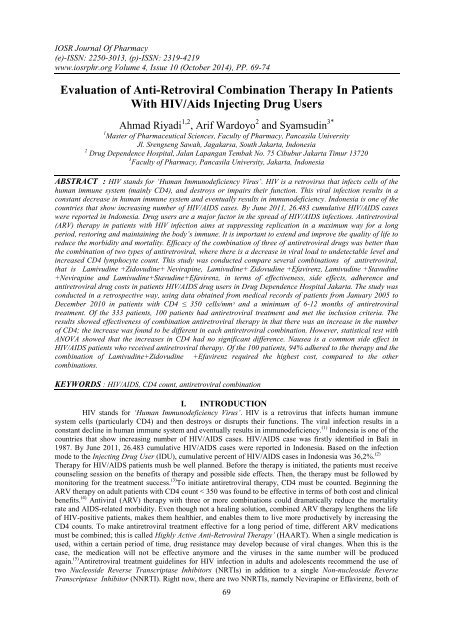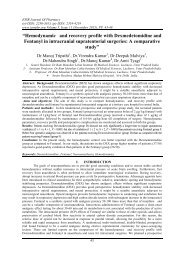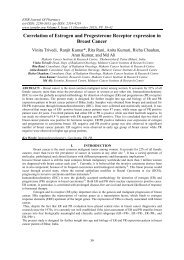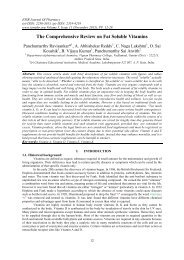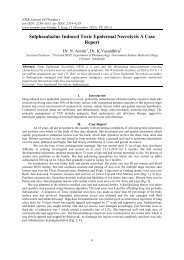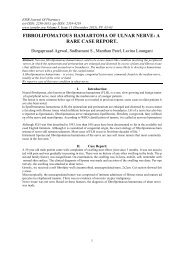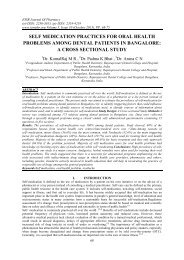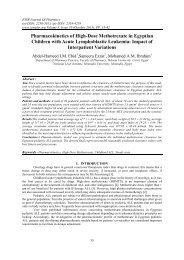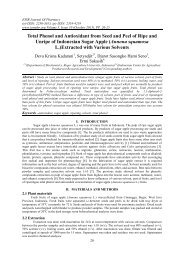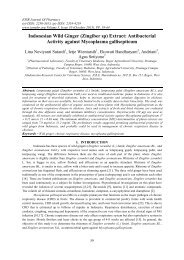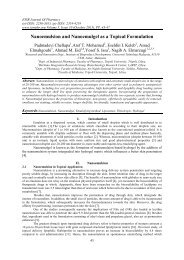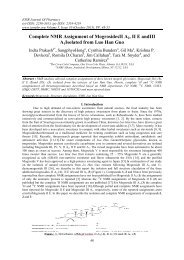Evaluation of Anti-Retroviral Combination Therapy In Patients With HIV/Aids Injecting Drug Users
Create successful ePaper yourself
Turn your PDF publications into a flip-book with our unique Google optimized e-Paper software.
IOSR Journal Of Pharmacy<br />
(e)-ISSN: 2250-3013, (p)-ISSN: 2319-4219<br />
www.iosrphr.org Volume 4, Issue 10 (October 2014), PP. 69-74<br />
<strong>Evaluation</strong> <strong>of</strong> <strong>Anti</strong>-<strong>Retroviral</strong> <strong>Combination</strong> <strong>Therapy</strong> <strong>In</strong> <strong>Patients</strong><br />
<strong>With</strong> <strong>HIV</strong>/<strong>Aids</strong> <strong>In</strong>jecting <strong>Drug</strong> <strong>Users</strong><br />
Ahmad Riyadi 1,2 , Arif Wardoyo 2 and Syamsudin 3*<br />
1 Master <strong>of</strong> Pharmaceutical Sciences, Faculty <strong>of</strong> Pharmacy, Pancasila University<br />
Jl. Srengseng Sawah, Jagakarsa, South Jakarta, <strong>In</strong>donesia<br />
2 <strong>Drug</strong> Dependence Hospital, Jalan Lapangan Tembak No. 75 Cibubur Jakarta Timur 13720<br />
3 Faculty <strong>of</strong> Pharmacy, Pancasila University, Jakarta, <strong>In</strong>donesia<br />
ABSTRACT : <strong>HIV</strong> stands for ‘Human Immunodeficiency Virus’. <strong>HIV</strong> is a retrovirus that infects cells <strong>of</strong> the<br />
human immune system (mainly CD4), and destroys or impairs their function. This viral infection results in a<br />
constant decrease in human immune system and eventually results in immunodeficiency. <strong>In</strong>donesia is one <strong>of</strong> the<br />
countries that show increasing number <strong>of</strong> <strong>HIV</strong>/AIDS cases. By June 2011, 26.483 cumulative <strong>HIV</strong>/AIDS cases<br />
were reported in <strong>In</strong>donesia. <strong>Drug</strong> users are a major factor in the spread <strong>of</strong> <strong>HIV</strong>/AIDS infections. <strong>Anti</strong>retroviral<br />
(ARV) therapy in patients with <strong>HIV</strong> infection aims at suppressing replication in a maximum way for a long<br />
period, restoring and maintaining the body’s immune. It is important to extend and improve the quality <strong>of</strong> life to<br />
reduce the morbidity and mortality. Efficacy <strong>of</strong> the combination <strong>of</strong> three <strong>of</strong> antiretroviral drugs was better than<br />
the combination <strong>of</strong> two types <strong>of</strong> antiretroviral, where there is a decrease in viral load to undetectable level and<br />
increased CD4 lymphocyte count. This study was conducted compare several combinations <strong>of</strong> antiretroviral,<br />
that is Lamivudine +Zidovudine+ Nevirapine, Lamivudine+ Zidovudine +Efavirenz, Lamivudine +Stavudine<br />
+Nevirapine and Lamivudine+Stavudine+Efavirenz, in terms <strong>of</strong> effectiveness, side effects, adherence and<br />
antiretroviral drug costs in patients <strong>HIV</strong>/AIDS drug users in <strong>Drug</strong> Dependence Hospital Jakarta. The study was<br />
conducted in a retrospective way, using data obtained from medical records <strong>of</strong> patients from January 2005 to<br />
December 2010 in patients with CD4 ≤ 350 cells/mmᵌ and a minimum <strong>of</strong> 6-12 months <strong>of</strong> antiretroviral<br />
treatment. Of the 333 patients, 100 patients had antiretroviral treatment and met the inclusion criteria. The<br />
results showed effectiveness <strong>of</strong> combination antiretroviral therapy in that there was an increase in the number<br />
<strong>of</strong> CD4; the increase was found to be different in each antiretroviral combination. However, statistical test with<br />
ANOVA showed that the increases in CD4 had no significant difference. Nausea is a common side effect in<br />
<strong>HIV</strong>/AIDS patients who received antiretroviral therapy. Of the 100 patients, 94% adhered to the therapy and the<br />
combination <strong>of</strong> Lamivudine+Zidovudine +Efavirenz required the highest cost, compared to the other<br />
combinations.<br />
KEYWORDS : <strong>HIV</strong>/AIDS, CD4 count, antiretroviral combination<br />
I. INTRODUCTION<br />
<strong>HIV</strong> stands for ‘Human Immunodeficiency Virus’. <strong>HIV</strong> is a retrovirus that infects human immune<br />
system cells (particularly CD4) and then destroys or disrupts their functions. The viral infection results in a<br />
constant decline in human immune system and eventually results in immunodeficiency. (1) <strong>In</strong>donesia is one <strong>of</strong> the<br />
countries that show increasing number <strong>of</strong> <strong>HIV</strong>/AIDS cases. <strong>HIV</strong>/AIDS case was firstly identified in Bali in<br />
1987. By June 2011, 26.483 cumulative <strong>HIV</strong>/AIDS cases were reported in <strong>In</strong>donesia. Based on the infection<br />
mode to the <strong>In</strong>jecting <strong>Drug</strong> User (IDU), cumulative percent <strong>of</strong> <strong>HIV</strong>/AIDS cases in <strong>In</strong>donesia was 36,2%. (2)<br />
<strong>Therapy</strong> for <strong>HIV</strong>/AIDS patients mush be well planned. Before the therapy is initiated, the patients must receive<br />
counseling session on the benefits <strong>of</strong> therapy and possible side effects. Then, the therapy must be followed by<br />
monitoring for the treatment success. (3) To initiate antiretroviral therapy, CD4 must be counted. Beginning the<br />
ARV therapy on adult patients with CD4 count < 350 was found to be effective in terms <strong>of</strong> both cost and clinical<br />
benefits. (4) <strong>Anti</strong>viral (ARV) therapy with three or more combinations could dramatically reduce the mortality<br />
rate and AIDS-related morbidity. Even though not a healing solution, combined ARV therapy lengthens the life<br />
<strong>of</strong> <strong>HIV</strong>-positive patients, makes them healthier, and enables them to live more productively by increasing the<br />
CD4 counts. To make antiretroviral treatment effective for a long period <strong>of</strong> time, different ARV medications<br />
must be combined; this is called Highly Active <strong>Anti</strong>-<strong>Retroviral</strong> <strong>Therapy</strong>’ (HAART). When a single medication is<br />
used, within a certain period <strong>of</strong> time, drug resistance may develop because <strong>of</strong> viral changes. When this is the<br />
case, the medication will not be effective anymore and the viruses in the same number will be produced<br />
again. (5) <strong>Anti</strong>retroviral treatment guidelines for <strong>HIV</strong> infection in adults and adolescents recommend the use <strong>of</strong><br />
two Nucleoside Reverse Transcriptase <strong>In</strong>hibitors (NRTIs) in addition to a single Non-nucleoside Reverse<br />
Transcriptase <strong>In</strong>hibitor (NNRTI). Right now, there are two NNRTIs, namely Nevirapine or Effavirenz, both <strong>of</strong><br />
69
<strong>Evaluation</strong> <strong>of</strong> <strong>Anti</strong>-<strong>Retroviral</strong> <strong>Combination</strong>…<br />
which show the same effectiveness as that <strong>of</strong> antiviral therapy. (4) Efficacy <strong>of</strong> three combined ARVs was<br />
found to be better than the combined two ARVs, since a decrease in viral load up to an undetectable level and<br />
increase in the number <strong>of</strong> lymphocyte DC4 counts were found. (6) <strong>HIV</strong> therapy using combined three<br />
antiretroviral medications was found to be very effective in terms <strong>of</strong> cost. (7) <strong>Anti</strong>retroviral regimens with two<br />
NRTI and PI, NNRTI or NRTI showed comparable effectiveness. The principle <strong>of</strong> simplicity, such as the daily<br />
doses (number <strong>of</strong> tablets for a day), must be a consideration in selecting a treatment regimen. (6) The study aims<br />
at answering some questions related to the comparison <strong>of</strong> CD4 count, body weight, adverse effects, adherence,<br />
and treatment cost <strong>of</strong> some combined ARV therapies for <strong>HIV</strong>/AIDS patients using narcotics, psychotropic, and<br />
addictive substances at <strong>Drug</strong> Dependence Hospital, Jakarta.<br />
II. MATERIALS AND METHODS<br />
Focus : The study was conducted at the <strong>HIV</strong> outpatient clinic <strong>of</strong> <strong>Drug</strong> Dependence Hospital, Jakarta – a<br />
specialty hospital that provides services to those with abuse <strong>of</strong> drugs, alcohol and other addictive substances.<br />
Population : Participants <strong>of</strong> the research were all new admissions for <strong>HIV</strong>/AIDS cases at <strong>Drug</strong> Dependence<br />
Hospital Jakarta from January 2005 to December 2010; 100 patients were selected.<br />
Study design : This was a retrospective study. Random sampling was done every day during routine visits until<br />
the desired sample size was reached. Samples <strong>of</strong> the research were all new admissions for <strong>HIV</strong>/AIDS cases at<br />
<strong>Drug</strong> Dependence Hospital Jakarta from January 2005 to December 2010; 300 patients were admitted during the<br />
period. The criterion for statistical significance was p value < 0.05.<br />
<strong>In</strong>clusion criteria : <strong>HIV</strong>-1 infected male and female patients aged 15 years and older on HAART, regularly<br />
reviewed for complaints during six months or more <strong>of</strong> treatment were deemed eligible for this study. <strong>Patients</strong><br />
were <strong>In</strong>jecting <strong>Drug</strong> <strong>Users</strong> (IDU) with CD4 ≤ 350 cells/mm 3 , under ARV treatment for 6-12 months, and having<br />
one <strong>of</strong> the following ARV therapies: <strong>Combination</strong> I: Lamivudine + Zidovudine + Nevirapine; <strong>Combination</strong> II:<br />
Lamivudine + Zidovudine + Efavirenz; <strong>Combination</strong> III: Lamivudine + Stavudine + nevirapine; <strong>Combination</strong><br />
IV Lamivudine + Stavudine + Efavirenz.<br />
Exclusion criteria : <strong>Patients</strong> on HAART for less than 6 months<br />
.<br />
Patient assessment : The Comprehensive Care Centre operated five days a week. All patients underwent full<br />
evaluation at initial and subsequent follow-up visits. Data on patient characteristics such as age, gender, marital<br />
status, occupation, level <strong>of</strong> education, WHO clinical staging, current and prior anti-retroviral therapy, physical<br />
examination findings and baseline CD4 counts were recorded in the patients’ charts.<br />
III. RESULTS<br />
The <strong>Drug</strong> Dependence Hospital (RSKO) Jakarta is one <strong>of</strong> referral hospitals for <strong>HIV</strong>/AIDS therapy. It<br />
provides healthcare services and management for <strong>HIV</strong>/AIDS patients. The team <strong>of</strong> doctor works by referring to<br />
National Guidelines for ARV <strong>Therapy</strong> issued by the central government and by referring to WHO guidelines.<br />
<strong>Patients</strong>’ data for the research were taken from January 2005 – December 2010. Of the 333 patients recorded to<br />
have ARV therapy, 100 patients met the inclusion criteria.<br />
<strong>Patients</strong>’ baseline characteristics<br />
The <strong>Patients</strong> in this research were mostly male (99%), within age range <strong>of</strong> 25-49 years (82%), living in East<br />
Jakarta (37%), unmarried (65%), unemployed (77%), and Senior High School graduates (74%).<br />
Table 1. Demographic characteristic <strong>of</strong> the study population<br />
Age<br />
Gender<br />
Marital Status<br />
Employment<br />
Variable No <strong>of</strong> patients Mean (%)<br />
15-19<br />
0<br />
0<br />
20-24<br />
18<br />
18<br />
25-49<br />
82<br />
82<br />
>50<br />
0<br />
0<br />
Male<br />
99<br />
99<br />
Female<br />
1<br />
1<br />
Unmarried<br />
65<br />
65<br />
Married<br />
35<br />
35<br />
Employed<br />
23<br />
23<br />
70
<strong>Evaluation</strong> <strong>of</strong> <strong>Anti</strong>-<strong>Retroviral</strong> <strong>Combination</strong>…<br />
status<br />
Unemployed<br />
77<br />
77<br />
Education<br />
Elementary School<br />
Junior High School<br />
Senior High School<br />
Bachelor<br />
1<br />
4<br />
74<br />
21<br />
1<br />
4<br />
74<br />
21<br />
The greatest proportion <strong>of</strong> <strong>HIV</strong> infections found at <strong>Drug</strong> Dependence Hospital occurred with shared <strong>In</strong>jecting<br />
drug use (IDU).<br />
ARV <strong>Combination</strong> : <strong>In</strong> this research, the mostly used ARVs were <strong>Combination</strong> I (lamivudine + zidovudine) +<br />
nevirapine (55%). The use <strong>of</strong> <strong>Combination</strong> I was the first-line ARV combination specified by the government<br />
for the patients without liver function and blood disorders. The <strong>Combination</strong> I was chosen since it was easily<br />
available and produced in <strong>In</strong>donesia.<br />
Figure 1. ARV <strong>Combination</strong> used for <strong>Therapy</strong> in <strong>HIV</strong>/AIDS <strong>Patients</strong><br />
<strong>In</strong>itial Diagnosis : An investigation for the initial diagnosis <strong>of</strong> <strong>HIV</strong>/AIDS patients may provide early diagnosis<br />
that the patients will get the treatment earlier.<br />
<strong>In</strong>itial Diagnosis<br />
Table II. <strong>In</strong>itial Diagnoses<br />
Fever, Decreasing BW,<br />
weakness, nausea<br />
Fever, nausea, vomiting,<br />
asphyxia, cough<br />
Fever, diarrhea, dry mouth,<br />
candidiasis<br />
Fever decreasing BW, cough,<br />
Candidiasis<br />
No. <strong>of</strong><br />
<strong>Patients</strong><br />
n =100<br />
Mean<br />
(%)<br />
29 27.10<br />
30 28.04<br />
18 16.82<br />
30 28.04<br />
Adherence : Adherence to therapy refers to a condition in which a patient willingly adheres to the treatment<br />
regimen, rather than a mere submission to the health staff’s order. Willingness is very important to ensure that<br />
the patient adheres to the dosing time. The adherence must be regularly monitored and evaluated at each visit.<br />
Failure <strong>of</strong> ARV therapy was frequently attributed to non-adherence <strong>of</strong> the patient to take ARV doses. <strong>In</strong> this<br />
research, adherence was assessed based on the attendance for doctor counseling and timeliness in each visit.<br />
Percent visit adherence was calculated each month by counting the difference in the visiting date in the next<br />
month. Most <strong>HIV</strong>/AIDS patients (94%) at <strong>Drug</strong> Dependence Hospital, Jakarta, adhered to the ARV therapy.<br />
71
<strong>Evaluation</strong> <strong>of</strong> <strong>Anti</strong>-<strong>Retroviral</strong> <strong>Combination</strong>…<br />
Opportunistic <strong>In</strong>fection : The course <strong>of</strong> <strong>HIV</strong> infection is relatively long – up to 10 years. As a result, a <strong>HIV</strong>infected<br />
patient may not recognize his condition. <strong>HIV</strong> infection is usually detected when there is an<br />
opportunistic infection that leads to <strong>HIV</strong> infection diagnosis. The opportunistic infections include oral<br />
candidiasis and tuberculosis. The types <strong>of</strong> opportunistic infections among <strong>HIV</strong>/AIDS patients include oral<br />
candidiasis, lung TB, cerebral toxoplasmosis, chronic diarrhea, peritoneal tuberculosis, Tuberculous<br />
lymphadenitis, and tuberculous meningitis. <strong>In</strong> patients with low CD4 count, some opportunistic infections may<br />
occur at the same time. : <strong>In</strong> this research, the most common opportunistic infections were oral candidiasis (40%)<br />
and lung TB (24%), since both oral candidiasis and TB may infect patients with high CD4 count. Therefore,<br />
even though a patient has ARV therapy and CD4 increases, oral candidiasis may recur during the ARV therapy.<br />
According to opportunistic infection data reported by June 2011, TBC, diarrhea, and candidiasis were the most<br />
common cases. (8)<br />
Adverse effects : Side effect is one <strong>of</strong> the important aspects in ARV therapy. Moreover, side effect is frequently<br />
used as a medical reason to substitute and/or to terminate ARV therapy. The patients sometimes cease the<br />
therapy on their own initiatives due to the adverse effects. <strong>Drug</strong> adverse effects must not be a barrier to initiate<br />
ARV therapy, since not all patients develop adverse effects and most drug adverse effects could be managed<br />
well. This is far more beneficial compared to the death risk when the patients do not receive ARV therapy.(9) <strong>In</strong><br />
this research, 34% <strong>of</strong> the patients did not report any adverse effects. One <strong>of</strong> the common adverse effects among<br />
<strong>HIV</strong>/AIDS patients was nausea (30%), since ARV makes use <strong>of</strong> peroral pathway, where it may irritate and<br />
increase gastric acid level.<br />
Table III. <strong>Drug</strong> Adverse Effects Based on ARV <strong>Combination</strong><br />
ARV Adverse Effects Freq. Percent<br />
Nausea 16 29.09<br />
Anemia 6 10.91<br />
Skin rush 4 7.27<br />
<strong>Combination</strong> I Headache 6 10.91<br />
<strong>In</strong>creasing AST/ALT 2 3.64<br />
Itching 3 5.45<br />
No adverse effect 18 32.73<br />
Nausea 3 17.65<br />
<strong>Combination</strong> II Anemia 2 11.76<br />
Headache 5 29.41<br />
No adverse effect 7 41.18<br />
Nausea 1 12.50<br />
Skin rush 1 12.50<br />
<strong>Combination</strong> III <strong>In</strong>creasing AST/ALT 1 12.50<br />
Itching 1 12.50<br />
No adverse effect 4 50.00<br />
Nausea 10 50.00<br />
Anemia 3 15.00<br />
<strong>Combination</strong> IV Headache 1 5.00<br />
Itching 1 5.00<br />
No adverse effect 5 25.00<br />
<strong>In</strong>crease in CD4 Count in the Four <strong>Combination</strong>s :<strong>In</strong> this research, measurement <strong>of</strong> CD4 count in 100<br />
patients that met the inclusion criteria revealed an increase in the CD4 count after 6-12 months <strong>of</strong> ARV therapy.<br />
The National Guideline for ARV <strong>Therapy</strong> recommends CD4 measurement for every 6 months to determine the<br />
effects and effectiveness <strong>of</strong> each ARV combination therapy. The four ARV combinations used in this research<br />
showed better effectiveness since they provide a CD4 increase <strong>of</strong> ≥ 50 cells/mm³ within 6-12 months <strong>of</strong> therapy.<br />
Table IV. Average increase in CD4 count related to each ARV <strong>Combination</strong> <strong>Therapy</strong><br />
ARV <strong>Combination</strong> No. <strong>of</strong> Mean SD<br />
<strong>Patients</strong> dCD4<br />
I 55 109,02 75,75<br />
II 17 117,65 75,33<br />
III 8 80,38 59,49<br />
IV 20 130,45 80,40<br />
72
<strong>Evaluation</strong> <strong>of</strong> <strong>Anti</strong>-<strong>Retroviral</strong> <strong>Combination</strong>…<br />
Comparison <strong>of</strong> Body Weight <strong>In</strong>crease Based on the ARV <strong>Combination</strong>s :The research also monitored the<br />
patient’s body weight at the beginning <strong>of</strong> therapy and during the 6-12 months <strong>of</strong> therapy.<br />
Table V. Average <strong>In</strong>crease <strong>of</strong> Bodyweight for each ARV combination<br />
ARV <strong>Combination</strong> No. Mean SD<br />
dCD4<br />
I 55 5,7818 9,689<br />
II 17 2,4118 6,3152<br />
III 8 3,25 3,8452<br />
IV 20 4,1 6,9578<br />
Of the 100 patients that met inclusion criteria, 55 patients received <strong>Combination</strong> I (AZT+3TC+NVP) with<br />
average/mean body weight increase <strong>of</strong> 5,7818 kg, 17 patients received <strong>Combination</strong> II (AZT+3TC+EFV) with<br />
average/mean body weight increase <strong>of</strong> 2,4118 kg, 8 patients received <strong>Combination</strong> III (d4T+3TC+NVP) with<br />
average/mean body weight increase <strong>of</strong> 3,25 kg, and 20 patients received <strong>Combination</strong> IV (d4T+3TC+EFV) with<br />
average/mean body weight increase <strong>of</strong> 4,1 kg.<br />
IV. DISCUSSION<br />
<strong>In</strong> this research, the mostly used ARVs were <strong>Combination</strong> I (lamivudine + zidovudine) + nevirapine<br />
(55%). The use <strong>of</strong> <strong>Combination</strong> I was the first-line ARV combination specified by the government for the<br />
patients without liver function and blood disorders. The <strong>Combination</strong> I was chosen since it was easily available<br />
and produced in <strong>In</strong>donesia.Other studies compared ARV combination in terms <strong>of</strong> virologic and immunological<br />
responses. They included a study by Li in China that assessed virologic response. He showed that virologic<br />
response was almost similar between the combination <strong>of</strong> zidovudin and stavudine. Virologic response in a<br />
prospective study on 198 patients with HAART in 52 weeks <strong>of</strong> examination showed a plasma viral load <strong>of</strong> < 50<br />
copies/patient in Group B that received NVP+3TC+d4T and those in Group C that received NVP+AZT+3TC,<br />
compared to those in Group A that received NVP+AZT+ddl [68,2%, 69% vs 39,7%, respectively, p < 0,001)<br />
(Li, 2008). Another retrospective study in Uganda showed a significant efficacy <strong>of</strong> AZT+3TC+EFV<br />
combination in 31 weeks <strong>of</strong> examination, with an average increase in CD4+ lymphocyte <strong>of</strong> 183. Virologic (viral<br />
load) suppression was not detected in 88,9% patients examined 11,6 weeks after the therapy.<br />
Of the 100 patients that met inclusion criteria, 55 patients received <strong>Combination</strong> I (AZT+3TC+NVP)<br />
with average/mean CD4 increase <strong>of</strong> 109,02 cells/mm³; 17 patients received <strong>Combination</strong> II II (AZT+3TC+EFV)<br />
with average/mean CD4 increase <strong>of</strong> 117,65 cells/mm³, 8 patients received <strong>Combination</strong> III (d4T+3TC+NVP)<br />
with average/mean CD4 increase <strong>of</strong> 80,38 cells/mm³, and 20 patients received <strong>Combination</strong> IV<br />
(d4T+3TC+EFV) with average/mean CD4 increase <strong>of</strong> 130,45 cells/mm³.Some previous studies suggested that<br />
baseline CD4 determined the increase <strong>of</strong> CD4 in the patients. The higher the CD4 count <strong>of</strong> <strong>HIV</strong>/AIDS patients<br />
when initiating the treatment, the higher the increase in CD4 counts (Evans, 2007). <strong>Patients</strong> that initiated the<br />
therapy with CD4 count <strong>of</strong> less than 200 cells/mm 3 showed almost two-fold failure <strong>of</strong> treatment (HR: 1,9)<br />
compared to those who initiated the therapy with CD4 count <strong>of</strong> more than 200 cells/mm 3 (Robbin, 2007). An<br />
adequate response in the patients receiving ARV therapy was defined as an annual CD4 increase <strong>of</strong> 50-150<br />
cells/mm 3 , with a quick response usually seen during the first month <strong>of</strong> treatment. (9) <strong>In</strong>creasing body weight<br />
among the <strong>HIV</strong>/AIDS patients represents a clinical response on the ARV therapy. <strong>In</strong>creasing CD4 counts among<br />
the <strong>HIV</strong>/AIDS patients is attributable to the improvement <strong>of</strong> immune system. The immune system does not<br />
always respond, so does the increase <strong>of</strong> body weight. This can be used as a marker <strong>of</strong> clinical condition. (10)<br />
Comparison <strong>of</strong> body weight increase based on the ARV combination using ANOVA revealed a significance<br />
value <strong>of</strong> 0,474 (higher than 0,05). This means that the increase <strong>of</strong> body weight for the four ARV combination<br />
therapies was not statistically different.<br />
<strong>In</strong>crease in the CD4 count among <strong>HIV</strong>/AIDS patients were the result <strong>of</strong> immune system improvement.<br />
The body does not always respond to the increase <strong>of</strong> body weight, which can be used as a clinical sign. (10)<br />
ANOVA showed a significance value <strong>of</strong> 0,474 – (above 0.05); therefore, increase in the body weight related to<br />
the four ARV combinations was not statistically different. The combination <strong>of</strong> the non-nucleoside reverse<br />
transcriptase inhibitor nevirapine (NVP), and two nucleoside reverse transcriptase inhibitors, stavudine (d4T)<br />
or zidovudine (AZT) and lamivudine (3TC), is widely used as first-line therapy (the second strategy),<br />
especially in low-resource countries.<br />
73
<strong>Evaluation</strong> <strong>of</strong> <strong>Anti</strong>-<strong>Retroviral</strong> <strong>Combination</strong>…<br />
V. CONCLUSION<br />
Of the four ARV combinations used in <strong>HIV</strong>/AIDS patient therapy, all were found to be effective in<br />
increasing CD4 counts. Statistical analyses did not reveal any significant difference in the increase <strong>of</strong> CD4 count<br />
and the increase <strong>of</strong> body weight. <strong>Combination</strong> I (Lamivudine + Zidovudine + Nevirapine ) was the most<br />
commonly used combination <strong>of</strong> all. The most common side effect <strong>of</strong> ARV therapy was nausea. Adherence <strong>of</strong><br />
<strong>HIV</strong>/AIDS patients to ARV therapy at RSKO was 94%.<br />
REFERENCES<br />
[1] Shete, A (2013). Current Trends in <strong>HIV</strong>/AIDS. J <strong>HIV</strong> AIDS <strong>In</strong>fect Dis 1: 1-2.<br />
[2] Ibrahim K, Songwathana P, Boonyasopun U, Francis K (2010) The <strong>HIV</strong>/AIDS epidemic in <strong>In</strong>donesia: does primary health care as a<br />
prevention and intervention strategy work? <strong>In</strong>t J Nurs Pract 16: 87–91.<br />
[3] Robertson J, Meier, M, Wall J, Ying J, Fichtenbaum C (2006). Immune reconstitution syndrome in <strong>HIV</strong>: validating a case<br />
definition and identifying clinical predictors in persons initiating antiretroviral therapy. Clin <strong>In</strong>fect Dis;42:1639-46.<br />
[4] Costello C, Nelson K, et al (2005). Predictors <strong>of</strong> low CD4 count in resource-limited settings based on an antiretroviral-naive<br />
heterosexual Thai population. JAIDS;39:242-8.<br />
[5] Alvarez (2004). Tenovir and Zidovudine/Lamivudine as Triple <strong>Therapy</strong> for <strong>In</strong>fection, Drexer University College <strong>of</strong> Medicine,<br />
Philadelphia, PA, USA, <strong>In</strong>ternational Journal <strong>of</strong> <strong>In</strong>fection Disease, ICID Vol. 8<br />
[6] Kenneth A. Freedberg, M.D., et al. (2001). The Cost Effectivennes Of <strong>Combination</strong> <strong>Anti</strong>retroviral Theraphy For <strong>HIV</strong> Disease, The<br />
New England Journal <strong>of</strong> Medicine, vol. 344, No.11<br />
[7] Koening SP et al, (2011) Cost Effectiveness <strong>of</strong> early versus antiretroviral therapy in <strong>HIV</strong>-infected adults in Haiti. PLoS Med 8(9).<br />
[8] Sungkanuparph S, Kiertiburanakul S, et al (2005). <strong>In</strong>itiation <strong>of</strong> highly active antiretroviral therapy in advanced AIDS with CD4<br />


